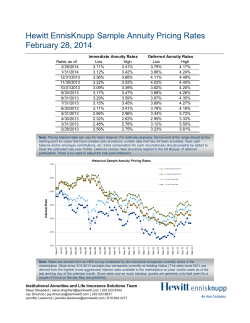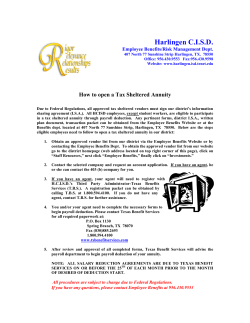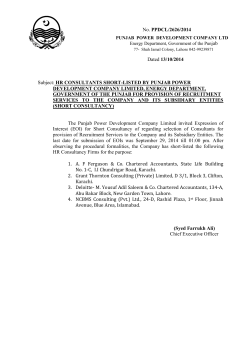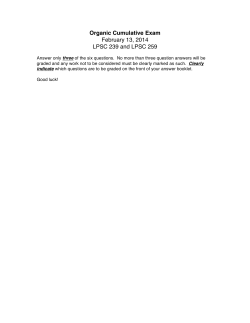
2 Time Value of Money
2 Time Value of Money BASIC CONCEPTS AND FORMULAE 1. 2. 3. 4. 5. Time Value It means money has time value. A rupee today is more valuable of Money than a rupee a year hence. We use rate of interest to express the time value of money. Simple Interest may be defined as Interest that is calculated as a Simple simple percentage of the original principal amount. Interest • Formula for Simple Interest Compound Interest SI = P0 (i)(n) Compound interest is the interest calculated on total of previously earned interest and the original principal. • Formula for Compound Interest FVn = P0 (1+i) n Present value of a sum of money to be received at a future date is Present determined by discounting the future value at the interest rate that Value of a the money could earn over the period. Sum of Money Future Value is the value at some future time of a present Future amount of money, or a series of payments, evaluated at a given Value interest rate. Formula for Future Value FVn = P0+ SI = P0 + P0(i)(n) r⎞ ⎛ Or, FVn = P0 ⎜1 + ⎟ ⎝ k⎠ 6. Annuity n An annuity is a series of equal payments or receipts occurring over a specified number of periods. • Present Value of an Ordinary Annuity: Cash flows occur at the end of each period, and present value is calculated as of one period before the first cash flow. © The Institute of Chartered Accountants of India 2.2 Financial Management • Present Value of an Annuity Due: Cash flows occur at the beginning of each period, and present value is calculated as of the first cash flow. Formula for Present Value of An Annuity Due PVAn = = R (PVIFi,n) • Future Value of an Ordinary Annuity: Cash flows occur at the end of each period, and future value is calculated as of the last cash flow. • Future Value of an Annuity Due: Cash flows occur at the beginning of each period, and future value is calculated as of one period after the last cash flow. Formula for Future Value of an Annuity Due FVAn = R (FVIFAi,n) 7. Sinking Fund It is the fund created for a specified purpose by way of sequence of periodic payments over a time period at a specified interest rate. Formula for Sinking Fund FVA=R [FVIFA(i,n)] Question 1 Explain the relevance of time value of money in financial decisions. Answer Time value of money means that worth of a rupee received today is different from the worth of a rupee to be received in future. The preference of money now as compared to future money is known as time preference for money. A rupee today is more valuable than rupee after a year due to several reasons: ¾ Risk − there is uncertainty about the receipt of money in future. ¾ Preference for present consumption − Most of the persons and companies in general, prefer current consumption over future consumption. ¾ Inflation − In an inflationary period a rupee today represents a greater real purchasing power than a rupee a year hence. ¾ Investment opportunities − Most of the persons and companies have a preference for present money because of availabilities of opportunities of investment for earning additional cash flow. © The Institute of Chartered Accountants of India Time Value of Money 2.3 Many financial problems involve cash flow accruing at different points of time for evaluating such cash flow an explicit consideration of time value of money is required. Question 2 A person is required to pay four equal annual payments of ` 4,000 each in his Deposit account that pays 10 per cent interest per year. Find out the future value of annuity at the end of 4 years. Answer ⎛ (1 + i) n − 1 ⎞ ⎟ FVA = A ⎜⎜ ⎟ i ⎝ ⎠ ⎛ (1 + 0.10) 4 − 1 ⎞ 4,000 ⎜ ⎟ 0.10 ⎝ ⎠ 4,000 × 4.641 = ` 18,564 Future Value of Annuity at the end of 4 years = ` 18,564 Question 3 A company offers a Fixed deposit scheme whereby ` 10,000 matures to ` 12,625 after 2 years, on a half-yearly compounding basis. If the company wishes to amend the scheme by compounding interest every quarter, what will be the revised maturity value? Answer Computation of Rate of Interest and Revised Maturity Value Principal = ` 10,000 Amount = ` 12,625 1 0,000 = Pn 12,625 (1 + i) 4 = A × (PVFn, i) 10,000 = 12,625 (PVF4, i) 0.7921 = (PVF4, i) According to the Table on Present Value Factor (PVF4,i) of a lump sum of Re. 1, a PVF of 0.7921 for half year at interest (i) = 6 percent. Therefore, the annual interest rate is 2 × 0.06 = 12 percent. i = 6% for half year © The Institute of Chartered Accountants of India 2.4 Financial Management i = 12% for full year. Therefore, Rate of Interest = 12% per annum 12 1 ⎞ ⎛ Revised Maturity Value = 1 0,000 ⎜ 1 + × ⎟ 100 4 ⎠ ⎝ 2× 4 8 3 ⎞ ⎛ = 1 0,000 ⎜ 1 + ⎟ = 10,000 (1.03)8 100 ⎠ ⎝ = 10,000 × 1.267 [Considering (CVF8,3) = 1.267] Revised Maturity Value = 12,670. Question 4 A doctor is planning to buy an X-Ray machine for his hospital. He has two options. He can either purchase it by making a cash payment of ` 5 lakhs or ` 6,15,000 are to be paid in six equal annual installments. Which option do you suggest to the doctor assuming the rate of return is 12 percent? Present value of annuity of Re. 1 at 12 percent rate of discount for six years is 4.111. Answer Advise to the Management Option I: Cash Down Payment Cash down payment= ` 5,00,000 Option II: Annual Installment Basis Annual installment = 6,15,000 × 1 = ` 1,02,500 6 Present Value of 1 to 6 instalments @12% = 1,02,500 × 4.111 = ` 4,21,378 Advise: The doctor should buy X-Ray machine on installment basis because the present value of cash out flows is lower than cash down payment. This means Option II is better than Option I. Question 5 Ascertain the compound value and compound interest of an amount of ` 75,000 at 8 percent compounded semiannually for 5 years. Answer Computation of Compound Value and Compound Interest Semiannual Rate of Interest (i) = 8/2 = 4 % © The Institute of Chartered Accountants of India Time Value of Money n = 5 x 2 = 10, 2.5 P = ` 75,000 Compound Value = P (1+i)n = 75,000 (1+4 %)10 = 75,000 x 1.4802 = ` 1,11,015 Compound Interest = ` 1,11,015 – ` 75,000 = ` 36,015 Question 6 X is invested ` 2,40,000 at annual rate of interest of 10 percent. What is the amount after 3 years if the compounding is done? (i) Annually (ii) Semi-annually. Answer Computation of Future Value Principal (P) = ` 2,40,000 Rate of Interest (ĭ) = 10% p.a. Time period (n)= 3 years Amount if compounding is done: (i) Annually Future Value = P (1 + ĭ )n 10 ⎞ ⎛ = 2,40,000 (1 + ⎜ 1 + ⎟ ⎝ 100 ⎠ = 2,40,000 ( 1 + 0.1) 3 3 = 2,40,000 x 1.331 = ` 3,19,440 (ii) Semi-Annually 10 ⎞ ⎛ Future Value = 2,40,000 ⎜ 1 + ⎟ ⎝ 100x 2 ⎠ = 2,40,000 ( 1 + 0.05) = 2,40,000 x ( 1.05) 6 6 = 2,40,000 x 1.3401 = ` 3,21,624 © The Institute of Chartered Accountants of India 3x 2 2.6 Financial Management Exercise 1. Ram has deposited ` 55,650 in a bank, which is paying 15 per cent rate of interest on a ten-year time deposit. Calculate the amount at the end of ten years? (Answer: ` 2,25,159.90) 2. Calculate the amount which Mr. Shyam should deposit now to receive ` 50,000 after 15 years. The interest rate is 9 per cent. (Answer: ` 13,750) 3. Mr. Pinto borrowed ` 1,00,000 from a bank on a one-year 8% term loan, with interest compounded quarterly. Determine the effective annual interest on the loan? (Answer: 8.24%) 4. Suppose Adit has borrowed a 3-year loan of ` 10,000 at 9 per cent from his employer to buy a motorcycle. If his employer requires three equal end-of-year repayments, then calculate the annual instalment. (Answer: ` 3,951) 5. The cost of a new mobile phone is ` 10,000. If the interest rate is 5 percent, how much would you have to set aside now to provide this sum in five years? (Answer: ` 7,840) © The Institute of Chartered Accountants of India
© Copyright 2025





















